2011 INFINITI QX56 ECO mode
[x] Cancel search: ECO modePage 1618 of 5598
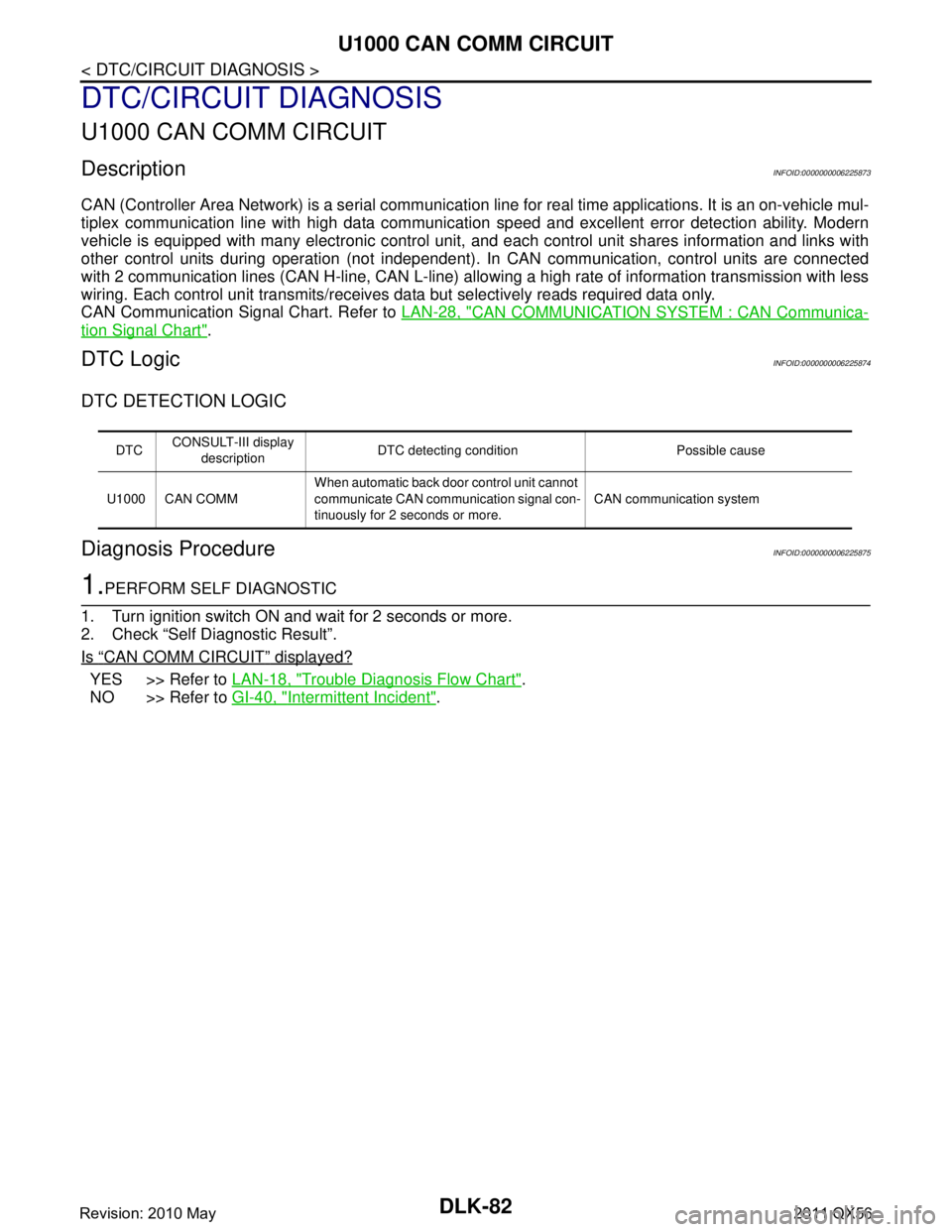
DLK-82
< DTC/CIRCUIT DIAGNOSIS >
U1000 CAN COMM CIRCUIT
DTC/CIRCUIT DIAGNOSIS
U1000 CAN COMM CIRCUIT
DescriptionINFOID:0000000006225873
CAN (Controller Area Network) is a serial communication line for real time applications. It is an on-vehicle mul-
tiplex communication line with high data communication speed and excellent error detection ability. Modern
vehicle is equipped with many electronic control unit, and each control unit shares information and links with
other control units during operation (not independent). In CAN communication, control units are connected
with 2 communication lines (CAN H-line, CAN L-line) al lowing a high rate of information transmission with less
wiring. Each control unit transmits/receives data but selectively reads required data only.
CAN Communication Signal Chart. Refer to LAN-28, "
CAN COMMUNICATION SYSTEM : CAN Communica-
tion Signal Chart".
DTC LogicINFOID:0000000006225874
DTC DETECTION LOGIC
Diagnosis ProcedureINFOID:0000000006225875
1.PERFORM SELF DIAGNOSTIC
1. Turn ignition switch ON and wait for 2 seconds or more.
2. Check “Self Diagnostic Result”.
Is
“CAN COMM CIRCUIT” displayed?
YES >> Refer to LAN-18, "Trouble Diagnosis Flow Chart".
NO >> Refer to GI-40, "
Intermittent Incident".
DTCCONSULT-III display
description DTC detecting condition Possible cause
U1000 CAN COMM When automatic back door control unit cannot
communicate CAN communication signal con-
tinuously for 2 seconds or more.
CAN communication system
Revision: 2010 May2011 QX56
Page 1620 of 5598

DLK-84
< DTC/CIRCUIT DIAGNOSIS >
B2401 IGNITION POWER SUPPLY CIRCUIT
B2401 IGNITION POWER SUPPLY CIRCUIT
DTC LogicINFOID:0000000006225878
DTC DETECTION LOGIC
DTC CONFIRMATION PROCEDURE
1.PERFORM DTC CONFIRMATION PROCEDURE
1. Turn ignition switch ON and wait for at least 1 second.
2. Check “Self Diagnostic Result” mode of “AUTOMAT IC BACK DOOR CONTROL UNIT” using CONSULT-
III.
Is DTC detected?
YES >> Refer to DLK-84, "Diagnosis Procedure".
NO >> INSPECTION END
Diagnosis ProcedureINFOID:0000000006225879
1.CHECK FUSE
1. Turn ignition switch OFF.
2. Check 10A fuse, [No. 4, located in fuse block (J/B)].
Is the inspection result normal?
YES >> GO TO 2.
NO >> Replace the blown fuse after repairing the affected circuit if a fuse is blown.
2.CHECK POWER SUPPLY CIRCUIT
1. Turn ignition switch OFF.
2. Disconnect automatic back door control unit connector.
3. Check voltage between automatic back door control unit harness connector and ground.
Is the measurement value normal?
YES >> Check intermittent incident. Refer to GI-40, "Intermittent Incident".
NO >> Repair or replace harness.
DTC CONSULT-III display
description DTC detecting condition Possible cause
B2401 IGN OPEN When the automatic back door control unit detects
the following condition for 0.3 second or more
Power supply condition (OFF) of automatic back
door control unit and Ignition position signal (ON)
from BCM via CAN Fuse
Harness or connectors
(Ignition power supply condition
circuit is open or shorted)
(+)
(− ) Condition Vo l ta g e
(Approx.)
Automatic back door control unit
Connector Terminal
B26 9 Ground Ignition switch ON Battery voltage
OFF 0 V
Revision: 2010 May2011 QX56
Page 1628 of 5598

DLK-92
< DTC/CIRCUIT DIAGNOSIS >
B2419 OPEN SWITCH
B2419 OPEN SWITCH
DTC LogicINFOID:0000000006225891
DTC DETECTION LOGIC
DTC CONFIRMATION PROCEDURE
1.PERFORM DTC CONFIRMATION PROCEDURE
1. Turn ignition switch ON.
2. Check “Self Diagnostic Result” mode of “AUTOMAT IC BACK DOOR CONTROL UNIT” using CONSULT-
III.
Is DTC detected?
YES >> Refer to DLK-92, "Diagnosis Procedure".
NO >> INSPECTION END
Diagnosis ProcedureINFOID:0000000006225892
1.CHECK OPEN SWITCH SIGNAL
1. Select “AUTOMATIC BACK DOOR CONTROL UNIT” using CONSULT-III.
2. Select “OPEN SW” in “DATA MONITOR” mode.
3. Check that the function operates normall y according to the following conditions.
Is the inspection result normal?
YES >> GO TO 6.
NO >> GO TO 2.
2.CHECK AUTOMATIC BACK DOOR CONTROL MODULE OUTPUT SIGNAL
1. Turn ignition switch OFF.
2. Disconnect back door lock assembly connector.
3. Check voltage between back door lock assembly harness connector and ground.
Is the inspection result normal?
YES >> GO TO 4.
NO >> GO TO 3.
DTC CONSULT-III display
description DTC detecting condition Possible cause
B2419 OPEN SW When the automatic back door control unit detects
any of the following conditions
The change of open switch cannot be detected
for 1 second or more after starting the closure
open output for the 3rd time in a row
The change of open switch cannot be detected for 0.5 second or more after starting the closure
close output for the 3rd time in a row
The condition that the open switch is in the ON position and the close switch is in the OFF posi-
tion is detected when starting the closure open/
close output for the 3rd time in a row Open switch
Harness or connectors
(Open switch circuit is open or
shorted)
Automatic back door control mod- ule
Monitor item Condition Status
OPEN SW Back door Fully closed/Half latch OFF
Open ON
(+)
(–)Voltag e
(Approx.)
Back door lock assembly
Connector Terminal D157 4 Ground Battery voltage
Revision: 2010 May2011 QX56
Page 1631 of 5598
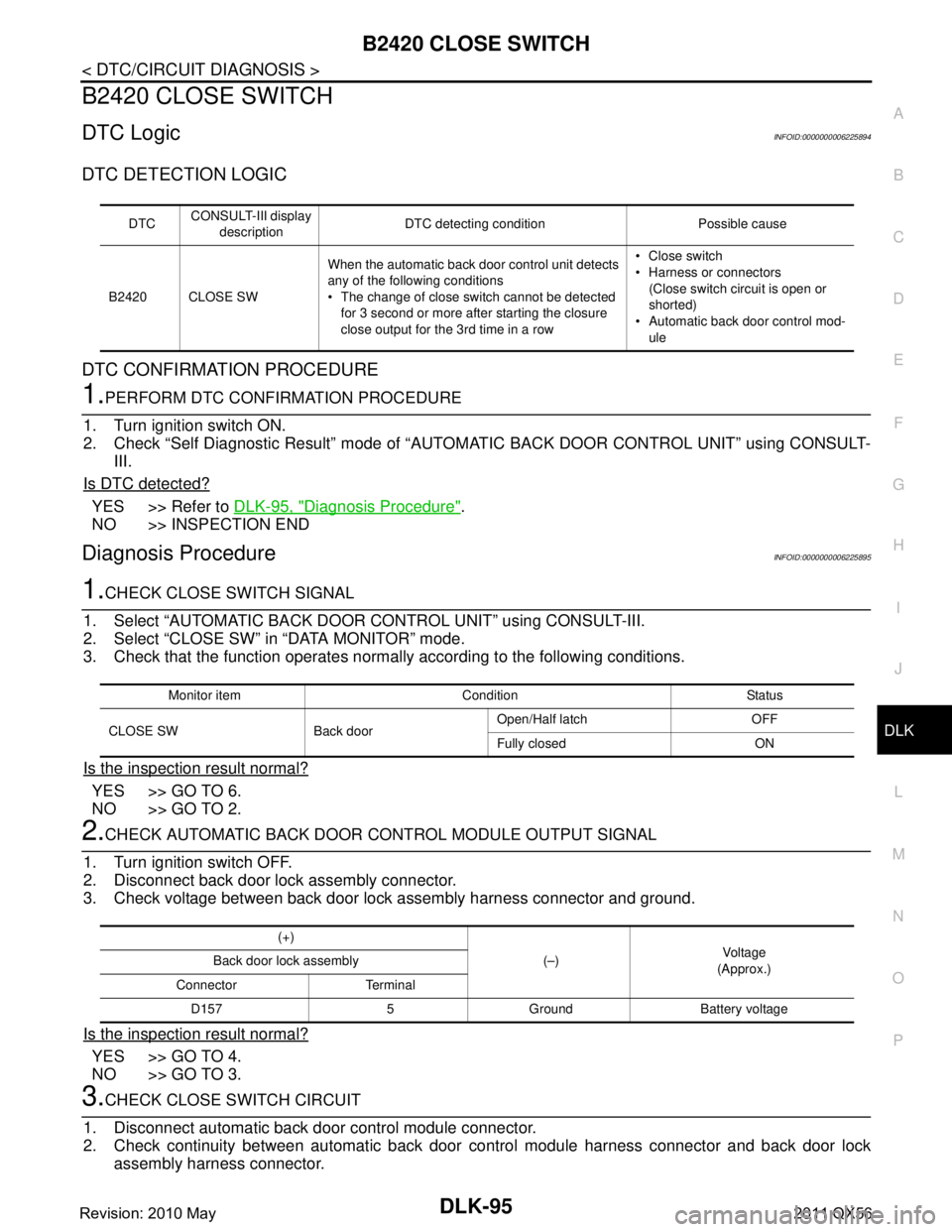
B2420 CLOSE SWITCHDLK-95
< DTC/CIRCUIT DIAGNOSIS >
C
DE
F
G H
I
J
L
M A
B
DLK
N
O P
B2420 CLOSE SWITCH
DTC LogicINFOID:0000000006225894
DTC DETECTION LOGIC
DTC CONFIRMATION PROCEDURE
1.PERFORM DTC CONFIRMATION PROCEDURE
1. Turn ignition switch ON.
2. Check “Self Diagnostic Result” mode of “AUTOMAT IC BACK DOOR CONTROL UNIT” using CONSULT-
III.
Is DTC detected?
YES >> Refer to DLK-95, "Diagnosis Procedure".
NO >> INSPECTION END
Diagnosis ProcedureINFOID:0000000006225895
1.CHECK CLOSE SWITCH SIGNAL
1. Select “AUTOMATIC BACK DOOR CONTROL UNIT” using CONSULT-III.
2. Select “CLOSE SW” in “DATA MONITOR” mode.
3. Check that the function operates normall y according to the following conditions.
Is the inspection result normal?
YES >> GO TO 6.
NO >> GO TO 2.
2.CHECK AUTOMATIC BACK DOOR CONTROL MODULE OUTPUT SIGNAL
1. Turn ignition switch OFF.
2. Disconnect back door lock assembly connector.
3. Check voltage between back door lock assembly harness connector and ground.
Is the inspection result normal?
YES >> GO TO 4.
NO >> GO TO 3.
3.CHECK CLOSE SWITCH CIRCUIT
1. Disconnect automatic back door control module connector.
2. Check continuity between automatic back door control module harness connector and back door lock
assembly harness connector.
DTC CONSULT-III display
description DTC detecting condition Possible cause
B2420 CLOSE SW When the automatic back door control unit detects
any of the following conditions
The change of close switch cannot be detected
for 3 second or more after starting the closure
close output for the 3rd time in a row Close switch
Harness or connectors
(Close switch circuit is open or
shorted)
Automatic back door control mod- ule
Monitor item Condition Status
CLOSE SW Back door Open/Half latch OFF
Fully closed ON
(+)
(–)Voltag e
(Approx.)
Back door lock assembly
Connector Terminal D157 5 Ground Battery voltage
Revision: 2010 May2011 QX56
Page 1635 of 5598
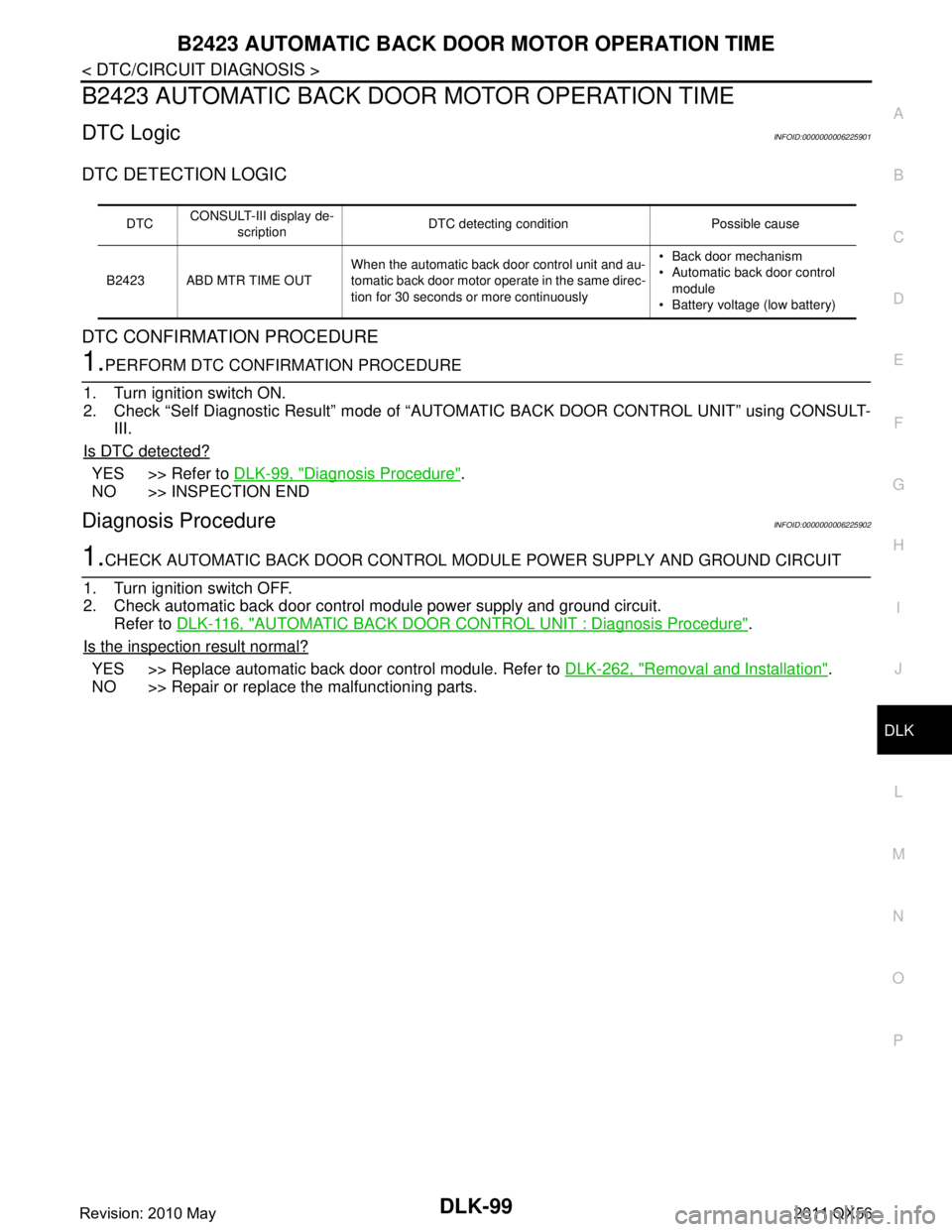
B2423 AUTOMATIC BACK DOOR MOTOR OPERATION TIMEDLK-99
< DTC/CIRCUIT DIAGNOSIS >
C
DE
F
G H
I
J
L
M A
B
DLK
N
O P
B2423 AUTOMATIC BACK DOOR MOTOR OPERATION TIME
DTC LogicINFOID:0000000006225901
DTC DETECTION LOGIC
DTC CONFIRMATION PROCEDURE
1.PERFORM DTC CONFIRMATION PROCEDURE
1. Turn ignition switch ON.
2. Check “Self Diagnostic Result” mode of “AUTOMAT IC BACK DOOR CONTROL UNIT” using CONSULT-
III.
Is DTC detected?
YES >> Refer to DLK-99, "Diagnosis Procedure".
NO >> INSPECTION END
Diagnosis ProcedureINFOID:0000000006225902
1.CHECK AUTOMATIC BACK DOOR CONTROL MODULE POWER SUPPLY AND GROUND CIRCUIT
1. Turn ignition switch OFF.
2. Check automatic back door control module power supply and ground circuit. Refer to DLK-116, "
AUTOMATIC BACK DOOR CONTROL UNIT : Diagnosis Procedure".
Is the inspection result normal?
YES >> Replace automatic back door control module. Refer to DLK-262, "Removal and Installation".
NO >> Repair or replace the malfunctioning parts.
DTC CONSULT-III display de-
scription DTC detecting condition Possible cause
B2423 ABD MTR TIME OUT When the automatic back door control unit and au-
tomatic back door motor operate in the same direc-
tion for 30 seconds or more continuously Back door mechanism
Automatic back door control
module
Battery voltage (low battery)
Revision: 2010 May2011 QX56
Page 1681 of 5598
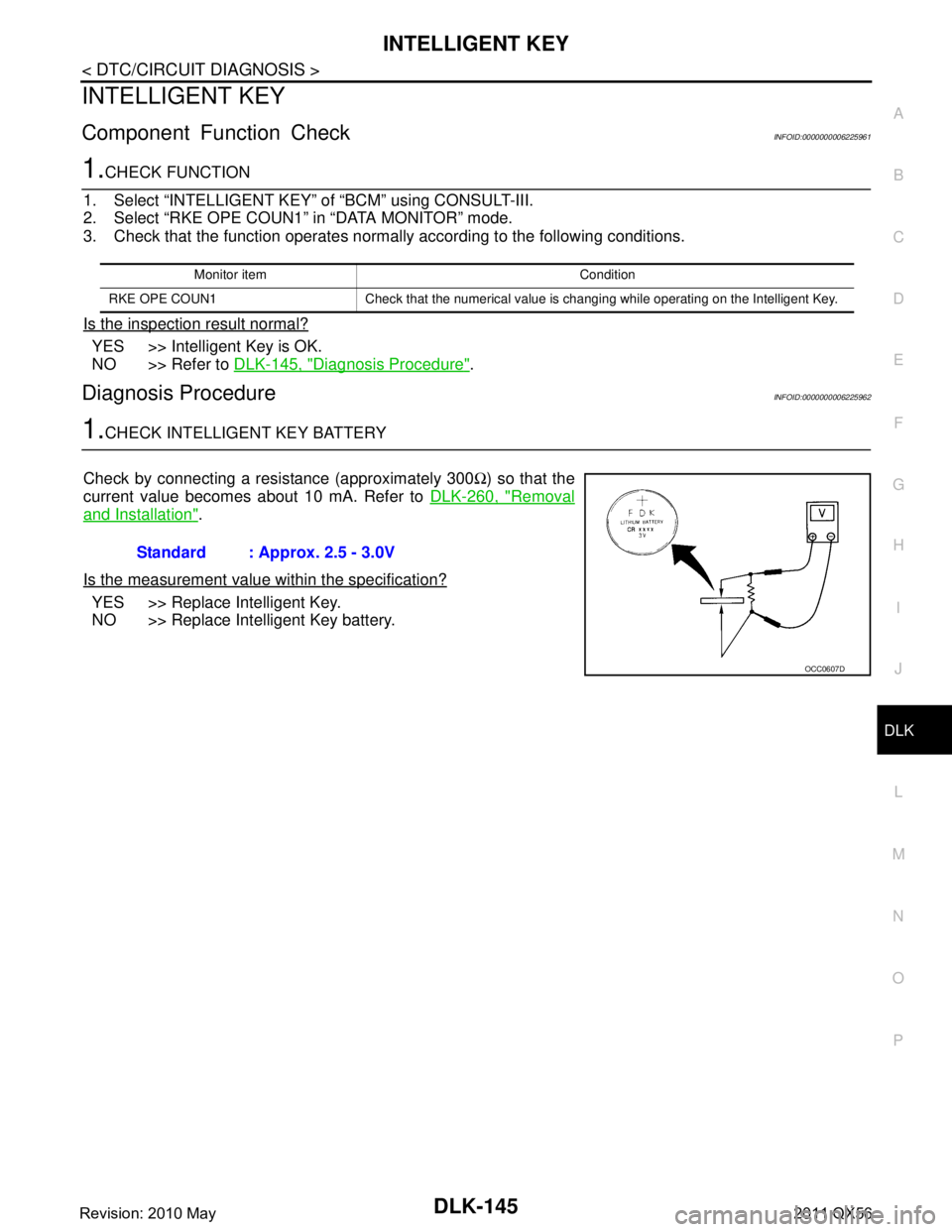
INTELLIGENT KEYDLK-145
< DTC/CIRCUIT DIAGNOSIS >
C
DE
F
G H
I
J
L
M A
B
DLK
N
O P
INTELLIGENT KEY
Component Function CheckINFOID:0000000006225961
1.CHECK FUNCTION
1. Select “INTELLIGENT KEY” of “BCM” using CONSULT-III.
2. Select “RKE OPE COUN1” in “DATA MONITOR” mode.
3. Check that the function operates normall y according to the following conditions.
Is the inspection result normal?
YES >> Intelligent Key is OK.
NO >> Refer to DLK-145, "
Diagnosis Procedure".
Diagnosis ProcedureINFOID:0000000006225962
1.CHECK INTELLIGENT KEY BATTERY
Check by connecting a resistance (approximately 300 Ω) so that the
current value becomes about 10 mA. Refer to DLK-260, "
Removal
and Installation".
Is the measurement value within the specification?
YES >> Replace Intelligent Key.
NO >> Replace Intelligent Key battery.
Monitor item Condition
RKE OPE COUN1 Check that the numerical value is changing while operating on the Intelligent Key.
Standard : Approx. 2.5 - 3.0V
OCC0607D
Revision: 2010 May2011 QX56
Page 1725 of 5598
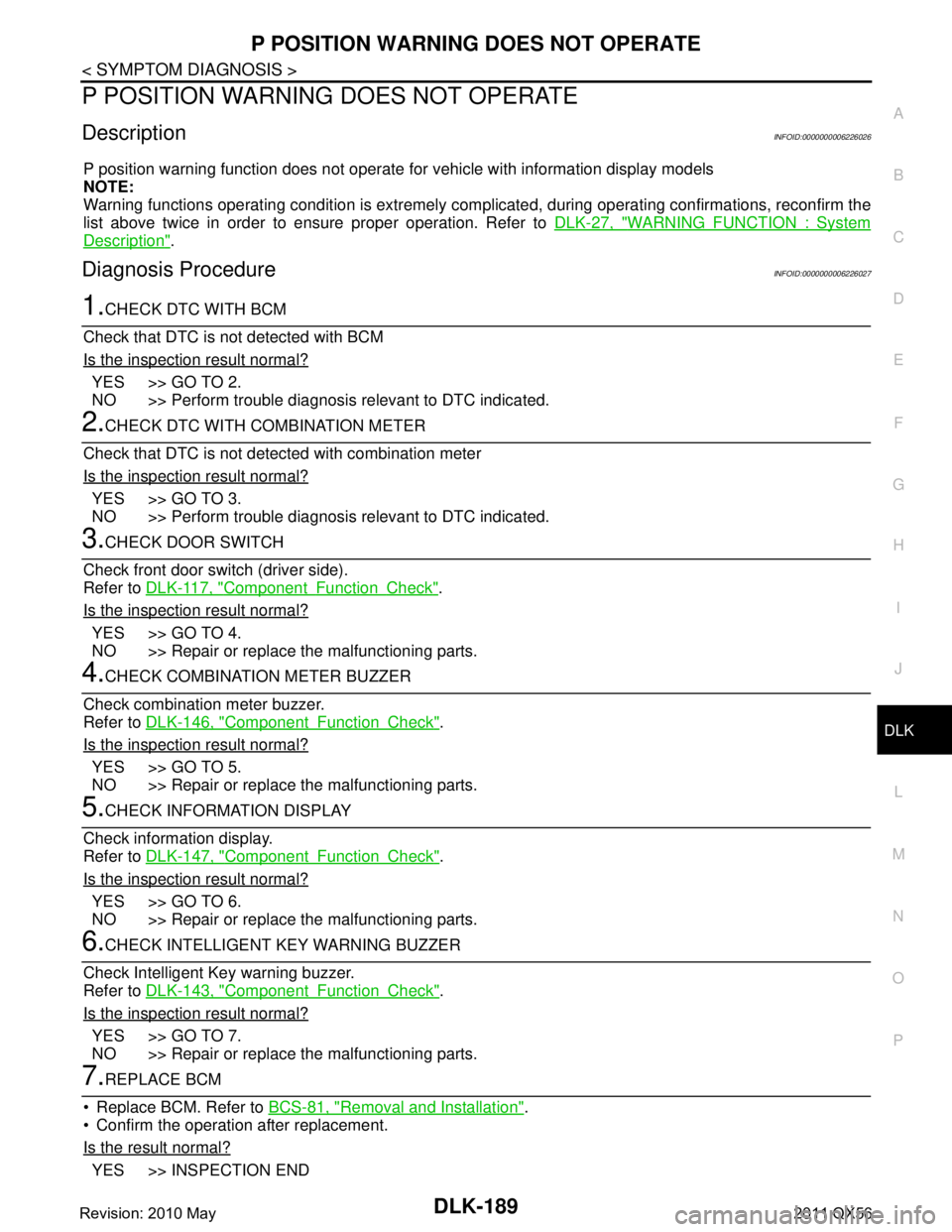
P POSITION WARNING DOES NOT OPERATEDLK-189
< SYMPTOM DIAGNOSIS >
C
DE
F
G H
I
J
L
M A
B
DLK
N
O P
P POSITION WARNING DOES NOT OPERATE
DescriptionINFOID:0000000006226026
P position warning function does not operate fo r vehicle with information display models
NOTE:
Warning functions operating condition is extremely comp licated, during operating confirmations, reconfirm the
list above twice in order to ensure proper operation. Refer to DLK-27, "
WARNING FUNCTION : System
Description".
Diagnosis ProcedureINFOID:0000000006226027
1.CHECK DTC WITH BCM
Check that DTC is not detected with BCM
Is the inspection result normal?
YES >> GO TO 2.
NO >> Perform trouble diagnosis relevant to DTC indicated.
2.CHECK DTC WITH COMBINATION METER
Check that DTC is not detected with combination meter
Is the inspection result normal?
YES >> GO TO 3.
NO >> Perform trouble diagnosis relevant to DTC indicated.
3.CHECK DOOR SWITCH
Check front door switch (driver side).
Refer to DLK-117, "
ComponentFunctionCheck".
Is the inspection result normal?
YES >> GO TO 4.
NO >> Repair or replace the malfunctioning parts.
4.CHECK COMBINATION METER BUZZER
Check combination meter buzzer.
Refer to DLK-146, "
ComponentFunctionCheck".
Is the inspection result normal?
YES >> GO TO 5.
NO >> Repair or replace the malfunctioning parts.
5.CHECK INFORMATION DISPLAY
Check information display.
Refer to DLK-147, "
ComponentFunctionCheck".
Is the inspection result normal?
YES >> GO TO 6.
NO >> Repair or replace the malfunctioning parts.
6.CHECK INTELLIGENT KEY WARNING BUZZER
Check Intelligent Key warning buzzer.
Refer to DLK-143, "
ComponentFunctionCheck".
Is the inspection result normal?
YES >> GO TO 7.
NO >> Repair or replace the malfunctioning parts.
7.REPLACE BCM
Replace BCM. Refer to BCS-81, "
Removal and Installation".
Confirm the operation after replacement.
Is the result normal?
YES >> INSPECTION END
Revision: 2010 May2011 QX56
Page 1727 of 5598

ACC WARNING DOES NOT OPERATEDLK-191
< SYMPTOM DIAGNOSIS >
C
DE
F
G H
I
J
L
M A
B
DLK
N
O P
ACC WARNING DOES NOT OPERATE
DescriptionINFOID:0000000006226028
ACC warning function does not operate for vehicle with information display models
NOTE:
Warning functions operating condition is extremely comp licated, during operating confirmations, reconfirm the
list above twice in order to ensure proper operation. Refer to DLK-27, "
WARNING FUNCTION : System
Description".
Diagnosis ProcedureINFOID:0000000006226029
1.CHECK DTC WITH BCM
Check that DTC is not detected with BCM
Is the inspection result normal?
YES >> GO TO 2.
NO >> Perform trouble diagnosis relevant to DTC indicated.
2.CHECK DTC WITH COMBINATION METER
Check that DTC is not detected with combination meter
Is the inspection result normal?
YES >> GO TO 3.
NO >> Perform trouble diagnosis relevant to DTC indicated.
3.CHECK COMBINATION METER BUZZER
Check combination meter buzzer.
Refer to DLK-146, "
ComponentFunctionCheck".
Is the inspection result normal?
YES >> GO TO 4.
NO >> Repair or replace the malfunctioning parts.
4.CHECK INFORMATION DISPLAY
Check information display.
Refer to DLK-147, "
ComponentFunctionCheck".
Is the inspection result normal?
YES >> GO TO 5.
NO >> Repair or replace the malfunctioning parts.
5.REPLACE BCM
Replace BCM. Refer to BCS-81, "
Removal and Installation".
Confirm the operation after replacement.
Is the result normal?
YES >> INSPECTION END
NO >> Check intermittent incident. Refer to GI-40, "
Intermittent Incident".
Revision: 2010 May2011 QX56